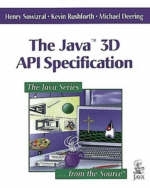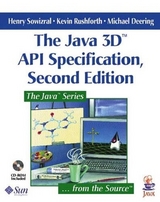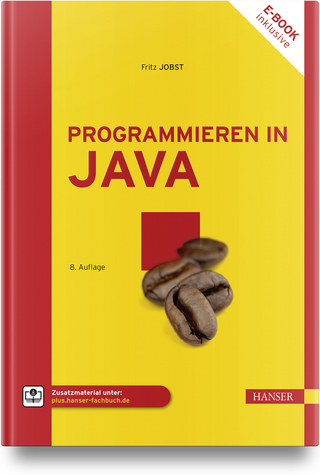
The Java™ 3D API Specification
Addison Wesley (Verlag)
978-0-201-32576-8 (ISBN)
- Titel erscheint in neuer Auflage
- Artikel merken
The Java 3D API, an exciting new part of the JavaMedia suite of APIs, enables the creation of three-dimensional graphics applications and Internet-based 3D applets. It gives developers high-level constructs for creating and manipulating 3D geometry and for building the structures used in rendering that geometry. With Java 3D, developers can efficiently define and render very large virtual worlds. Moreover, in line with Java's "write once, run anywhere" vision, applications written using Java 3D can run on a wide range of platforms and systems and are adapted for use on the Internet. This book represents the definitive Java 3D API specification, providing authoritative and detailed descriptions of each element of the API. It offers an informative overview of Java 3D, comprehensive instructions for "scene graph" definition and construction, and a detailed description of the Java 3D View Model, an innovative model enabling applications to be displayed on a wide array of devices. The book also covers: input devices, such as six-degrees-of-freedom trackers; picking mechanisms; behaviors and interpolators for animating objects; and audio capabilities.
The Java 3D Execution and Rendering Model is described in depth, including the immediate, retained, and compiled-retained modes. Comprehensive and definitive, this book is an essential reference for any Java programmer interested in entering the exciting world of three-dimensional Internet applications. 0201325764B04062001
Henry Sowizral, a Distinguished Engineer at Sun Microsystems, is the chief architect of the Java 3D API. He is an expert in virtual reality, large-model visualization, and distributed systems. He is co-inventor of the Time Warp simulation methodology. Kevin Rushforth, a Senior Staff Engineer at Sun Microsystems, is a co-architect of the Java 3D API. He has worked extensively in graphics hardware simulation, microcode, and graphics pipeline software. He is expert in such APIs as PHIGS+, XGL, and OpenGL, and such hardware devices as the Ultra Creator3D. Michael Deering is a Distinguished Engineer at Sun Microsystems, where he has led the company's 3D graphics technical strategy. He is a co-architect of the Java 3D API and was the chief architect for a number of Sun's 3D graphics hardware accelerators. He is an expert in virtual reality. 0201325764AB04062001
Preface.
1. Introduction to Java 3D.
Goals.
Programming Paradigm.
The Scene Graph Programming Model.
Rendering Modes.
Extensibility.
High Performance.
Layered Implementation.
Target Hardware Platforms.
Support for Building Applications and Applets.
Browsers.
Games.
Overview of Java 3D Object Hierarchy.
Structuring the Java 3D Program.
Java 3D Application Scene Graph.
Recipe for a Java 3D Program.
HelloUniverse: A Sample Java 3D Program.
2. Scene Graph Basics.
Scene Graph Structure.
Spatial Separation.
State Inheritance.
Rendering.
Scene Graph Objects.
Node Objects.
NodeComponent Objects.
Scene Graph Superstructure Objects.
VirtualUniverse Object.
Locale Object.
Scene Graph Viewing Objects.
Canvas3D Object.
Screen3D Object.
View Object.
PhysicalBody Object.
PhysicalEnvironment Object.
3. Scene Graph Superstructure.
The Virtual Universe.
Establishing a Scene.
Loading a Virtual Universe.
Coordinate Systems.
High-Resolution Coordinates.
Java 3D High-Resolution Coordinates.
Java 3D Virtual World Coordinates.
Details of High-Resolution Coordinates.
API for Superstructure Objects.
VirtualUniverse Object.
Locale Object.
HiResCoord Object.
4. Group Node Objects.
Group Node.
BranchGroup Node.
TransformGroup Node.
OrderedGroup Node.
DecalGroup Node.
Switch Node.
SharedGroup Node.
5. Leaf Node Objects.
Leaf Node.
Shape3D Node.
BoundingLeaf Node.
Background Node.
Clip Node.
Fog Node.
ExponentialFog Node.
LinearFog Node.
Light Node.
AmbientLight Node.
DirectionalLight Node.
PointLight Node.
SpotLight Node.
Sound Node.
BackgroundSound Node.
PointSound Node.
ConeSound Node.
Soundscape Node.
ViewPlatform Node.
Behavior Node.
Morph Node.
Link Node.
6. Reusing Scene Graphs.
Sharing Subgraphs.
SharedGroup Node.
Link Leaf Node.
Cloning Subgraphs.
References to Node Component Objects.
References to Other Scene Graph Nodes.
Dangling References.
Subclassing Nodes.
NodeReferenceTable Object.
Example User Behavior Node.
7. Node Component Objects.
Node Component Objects: Attributes.
Appearance Object.
ColoringAttributes Object.
LineAttributes Object.
PointAttributes Object.
PolygonAttributes Object.
RenderingAttributes Object.
TextureAttributes Object.
TransparencyAttributes Object.
Material Object.
Texture Object.
Texture2D Object.
Texture3D Object.
TexCoordGeneration Object.
MediaContainer Object.
AuralAttributes Object.
ImageComponent Object.
ImageComponent2D Object.
ImageComponent3D Object.
DepthComponent Object.
DepthComponentFloat Object.
DepthComponentInt Object.
DepthComponentNative Object.
Bounds Object.
BoundingBox Object.
BoundingSphere Object.
BoundingPolytope Object.
Transform3D Object.
Node Component Objects: Geometry.
GeometryArray Object.
PointArray Object.
LineArray Object.
TriangleArray Object.
QuadArray Object.
GeometryStripArray Object.
LineStripArray Object.
TriangleStripArray Object.
TriangleFanArray Object.
IndexedGeometryArray Object.
IndexedPointArray Object.
IndexedLineArray Object.
IndexedTriangleArray Object.
IndexedQuadArray Object.
IndexedGeometryStripArray Object.
IndexedLineStripArray Object.
IndexedTriangleStripArray Object.
IndexedTriangleFanArray Object.
CompressedGeometry Object.
CompressedGeometryHeader Object.
Raster Object.
Font3D Object.
FontExtrusion Object.
Text3D Geometry Object.
Math Component Objects.
Tuple Objects.
Matrix Objects.
8. View Model.
Why a New Model?
The Physical Environment Influences the View.
Separation of Physical and Virtual.
The Virtual World.
The Physical World.
The Objects That Define the View.
ViewPlatform: A Place in the Virtual World.
Moving Through the Virtual World.
Dropping In on a Favorite Place.
View Attach Policy.
Associating Geometry with a ViewPlatform.
Generating a View.
Composing Model and Viewing Transformations.
Multiple Locales.
A Minimal Environment.
The View Object.
Projection Policy.
Clip Policies.
Projection and Clip Parameters.
Frame Start Time and Duration.
Scene Antialiasing.
Depth Buffer.
The Screen3D Object.
The Canvas3D Object.
Window SystemProvided Parameters.
Other Canvas3D Parameters.
The PhysicalBody Object.
The PhysicalEnvironment Object.
9. Behaviors and Interpolators.
Behavior Object.
Code Structure.
WakeupCondition Object.
WakeupCriterion Object.
Composing WakeupCriterion Objects.
Composing Behaviors.
Scheduling.
How Java 3D Performs Execution Culling.
The Behavior API.
The Behavior Node.
WakeupCondition Object.
The WakeupCriterion Objects.
Interpolator Behaviors.
Mapping Time to Alpha.
Acceleration of Alpha.
The Alpha Class.
The Interpolator Base Class.
PositionInterpolator Object.
RotationInterpolator Object.
ColorInterpolator Object.
ScaleInterpolator Object.
SwitchValueInterpolator Object.
TransparencyInterpolator Object.
PositionPathInterpolator Object.
RotPosPathInterpolator Object.
RotPosScalePathInterpolator Object.
RotationPathInterpolator Object.
Level-of-Detail Behaviors.
LOD Object.
DistanceLOD Object.
Billboard Behavior.
10. Input Devices and Picking.
InputDevice Interface.
The Abstract Interface.
Instantiating and Registering a New Device.
Sensors.
Using and Assigning Sensors.
Behind the (Sensor) Scenes.
The Sensor Object.
The SensorRead Object.
Picking.
SceneGraphPath Object.
BranchGroup Node and Locale Node Pick Methods.
PickShape Object.
PickPoint Object.
PickRay Object.
PickSegment Object.
11. Audio Devices.
AudioDevice Interface.
Initialization.
Audio Playback.
Device-Driver-Specific Data.
Instantiating and Registering a New Device.
12. Execution and Rendering Model.
Three Major Rendering Modes.
Immediate Mode.
Retained Mode.
Compiled-Retained Mode.
Instantiating the Render Loop.
An Application-Level Perspective.
Retained and Compiled-Retained Rendering Modes.
13. Immediate-Mode Rendering.
Two Styles of Immediate-Mode Rendering.
Pure Immediate-Mode Rendering.
Mixed-Mode Rendering.
Canvas3D Methods.
API for Immediate Mode.
GraphicsContext3D.
Appendix A: Math Objects.
Tuple Objects.
Tuple2f Class.
Tuple3b Class.
Tuple3d Class.
Tuple3f Class.
Tuple4b Class.
Tuple4d Class.
Tuple4f Class.
AxisAngle4d Class.
AxisAngle4f Class.
GVector Class.
Matrix Objects.
Matrix3f Class.
Matrix3d Class.
Matrix4f Class.
Matrix4d Class.
GMatrix Class.
Appendix B: 3D Geometry Compression.
Compression.
Decompression.
Appendix Organization.
Generalized Triangle Strip.
Generalized Triangle Mesh.
Position Representation and Quantization.
Color Representation and Quantization.
Normal Representation and Quantization.
Normals as Indices.
Normal Encoding Parameterization.
Modified Huffman Encoding.
Geometry Compression Commands.
Bit Layout of Geometry Decompression Commands.
Geometry Decompression Command Bit Details.
NOP.
setState.
setTable.
meshBufferReference.
Position Subcommand.
Color Subcommand.
Normal Subcommand.
vertex.
normal.
color.
Semantics of Geometry Decompression Commands.
Header and Body to Variable-Length Command.
Variable-Length Command to Command.
Delta Position to Position.
Delta Color to Color.
Encoded Delta Normal to Encoded Normal.
Encoded Normal to Rectilinear Normal.
Semantics of Vertices.
Command to Vertex.
Vertex to Intermediate Triangle.
Intermediate Triangle to Final Triangle.
Outline of Geometry Process.
Compressing Geometry Data.
Convert to Generalized Mesh Format.
Position.
Normals.
Colors.
Collect Delta Code Statistics.
Position Delta Code Statistics.
Color Delta Code Statistics.
Normal Delta Code Statistics.
Assign Huffman Tags.
Assemble the Pieces into a Bit Stream.
Appendix C: View Model Details.
An Overview of the Java 3D View Model.
Physical Environments and Their Effects.
A Head-Mounted Example.
A Room-Mounted Example.
Impact of Head Position and Orientation on the Camera.
The Coordinate Systems.
Room-Mounted Coordinate Systems.
Head-Mounted Coordinate Systems.
The ViewPlatform Object.
The View Object.
View Policy.
Screen Scale Policy.
Window Eyepoint Policy.
Monoscopic View Policy.
Sensors and Their Location in the Virtual World.
The Screen3D Object.
Screen3D Calibration Parameters.
Accessing and Changing Head Tracker Coordinates.
The Canvas3D Object.
Scene Antialiasing.
Accessing and Modifying an Eye¹s Image Plate Position.
Canvas Width and Height.
The PhysicalBody Object.
The PhysicalEnvironment Object.
Viewing in Head-Tracked Environments.
A Room-Mounted Display with Head Tracking.
A Head-Mounted Display with Head Tracking.
Compatibility Mode.
Overview of the Camera-Based View Model.
Using the Camera-Based View Model.
Appendix D: Exceptions.
BadTransformException.
CapabilityNotSetException.
DanglingReferenceException.
IllegalSharingException.
MultipleParentException.
RestrictedAccessException.
SceneGraphCycleException.
SingularMatrixException.
SoundException.
Appendix E: Equations.
Fog Equations.
Lighting Equations.
Sound Equations.
Headphone Playback Equations.
Speaker Playback Equations.
Texture Mapping Equations.
Texture Lookup.
Texture Application.
Appendix F: VRML Support.
VRML 1.0.
Mapping VRML 1.0 Files onto Java 3D Objects.
A VRML 1.0 Browsing Environment.
VRML 2.0.
VRML Support Requires a VRML Runtime Environment.
An Approach.
A Browser.
Optimizing for Viewing versus Editing.
Glossary.
Index. 0201325764T04062001
| Erscheint lt. Verlag | 15.1.1998 |
|---|---|
| Verlagsort | Boston |
| Sprache | englisch |
| Maße | 187 x 234 mm |
| Gewicht | 865 g |
| Themenwelt | Mathematik / Informatik ► Informatik ► Grafik / Design |
| Informatik ► Programmiersprachen / -werkzeuge ► Java | |
| Mathematik / Informatik ► Informatik ► Web / Internet | |
| ISBN-10 | 0-201-32576-4 / 0201325764 |
| ISBN-13 | 978-0-201-32576-8 / 9780201325768 |
| Zustand | Neuware |
| Informationen gemäß Produktsicherheitsverordnung (GPSR) | |
| Haben Sie eine Frage zum Produkt? |
aus dem Bereich



